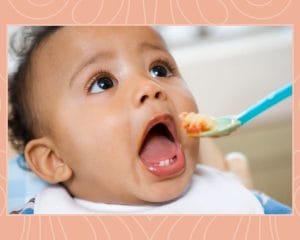These are the nutrients your child needs for optimal brain development, according to a developmental neurobiologist

Your baby's first three years are critical for brain development.
A version of this story was originally published April 5, 2021. It has been updated.
Table of Contents
As a neurosurgeon, I have always been in love with the brain. It’s an incredibly complex structure made up of around 100 billion neurons. And somehow, in this fascinating structure, is uniquely you. Not just your ability to move, and speak, and feel hot and cold and pain, but also your memories, the way you feel in those moments when everything seems just right and the way you cope when everything seems, well, off.
Your baby’s first three years are uniquely critical for brain development. First, it’s a period of astronomical growth. According to research, your baby’s brain grows up to 1% per day and makes thousands of neural connections per second. And whereas nearly all the cells in your body (skin, hair, lungs, heart) will self-renew over the course of your lifetime, the majority of the brain cells that you have at the age of three are the same brain cells that you will have for the rest of your life. So those first few years are a unique window of opportunity to support brain development and set children up for their best possible lives.
Related: Singing to your baby is great for their brain development, says new study
The brain has many different regions that develop at slightly different times. Well-performed studies looking at infant MRI brain scans have shown us that each month, different areas of the brain are in rapid growth mode. As a mama, you see this too. They seem to have these rapid bursts of cognitive, motor or visual development. Every week it seems like they are up to something new. Well, they are, and that’s a reflection of the different regions of the brain developing!
We also know from recent research that as regions of the brain grow, each requires its own set of specific nutrients to help support that development. There are times when folate is really key. When selenium becomes essential. When choline, zinc and thiamin are needed. What’s important is knowing the foods your baby should eat during each milestone.
Here are some examples of how specific nutrients can support each stage of your child’s brain development.
6 months
Your baby’s brain: Your baby’s visual development is on overdrive by 6 months. They will notice that they prefer more complex visual stimuli and are beginning to understand spatial relationships by observing and interacting with the people, objects and spaces around them. You may notice your baby now reaches for their favorite toy, attempting to grasp and maneuver it.
Foods to help them grow: During this time, vitamin A, lutein and iodine are known to support the primary visual cortex and the middle and superior occipital gyri that’s working hard at this age.
- Vitamin A can be found in carrots, sweet potatoes, spinach and butternut squash.
- Lutein comes from peas, broccoli, leafy greens and winter squashes, like pumpkin.
- Iodine can come from kelp, seaweed, shrimp, eggs and bananas.
Related: The best brain-boosting food for kids—and how to get them to eat it
7 months
Your baby’s brain: Around 7 months of age, your little one is getting better at balancing and coordinating muscle movement thanks to growth in areas of the brain responsible for motor development. Pretty soon they’ll be sitting without support and moving from hands and knees to a sitting position all on their own.
Fine motor skills are developing too, like the ability to transfer objects from one hand to another.
Foods to help them grow: That balance and coordination is driven by the cerebellum and it’s supported nutritionally by zinc, folate and niacin.
- Zinc can be found in spinach, beans, egg yolks and beef.
- Folate is found in foods like legumes, broccoli and leafy greens.
- Niacin (also known as vitamin B3) is great for helping little ones with motor control and can be found in squash seeds, beans and legumes.
Related: 10 nutrient-dense first foods for baby
12 months
Your baby’s brain: Around their first birthday, they’ll be strengthening important cognitive skills like attention and patience. During this time, little ones are able to find hidden objects and wait for someone else to pick up something they’ve dropped. The parietal lobe is a key brain region involved in cognitive development and attention, and protein and iron become important around this time.
Foods to help them grow: Provide them with plenty of protein and iron during this big building time.
- Protein, found in lean meats, fish, chicken, beans, lentils and chickpeas.
- Iron can be sourced from winter squashes, pumpkin, sweet potato, mushrooms, algae like chlorella, kelp and leafy greens.
18 months
Your baby’s brain: Around 18 months of age, they’re starting to pick up words and displaying more complicated thought processes. This more nuanced thought is reflective of regions of the frontal lobe developing and global myelination (laying down nerve lining) is picking up speed.
Foods to help them grow: Vitamin E, iron, protein and DHA, an omega-3 fatty acid, are essential during this time period.
- DHA sources include oily fish like salmon, tuna, trout, anchovies, herring, mackerel and fresh-water algae.
- Vitamin E, like in sunflower seeds, almonds and hazelnuts.
Related: 10 key foods to build your baby’s brain development
Age 2
Your baby’s brain: Around their second birthday, your kid is making huge strides and interacting with the world in more complex ways. They can probably follow two-step directions like, “Pick up your coat and bring it to me.” This is greatly aided by increased attention span and the ability to think abstractly.
Foods to help them grow: The parietal lobe is a key brain region in the spotlight during this phase as it’s involved in language processing, sensory integration, spatial awareness, numerical cognition and attention. The parietal lobe is shown to need protein and iron.
- Protein, found in lean meats, fish, chicken, beans, lentils and chickpeas.
- Iron can be sourced from winter squashes, pumpkin, sweet potato, mushrooms, algae like chlorella, kelp and leafy greens.
Related: 2-year-olds aren’t terrible–they’re just learning how to be human
While it can be challenging to keep track of the foods your little one eats (especially when they are picky) here are easy ways to incorporate nutrient-dense foods:
1. Explore different veggies & fruits
There are many essential nutrients that support healthy brain development and they aren’t all in your basic, everyday fruits and veggies. To make sure your little one is getting the nutrients they need, look to a wide variety of vegetables and fruits like kelp, maitake mushrooms, squash seeds, algal oil and sunflower seeds that have high nutritional density including DHA, iron, zinc and vitamin E.
2. Don’t be fooled by baby food packaging
Flip your food, as it’s the nutrition inside that counts. A box, jar or pouch may tout spinach on the front of the package, but if it only has 2% of a child’s daily value of iron, you are probably getting the equivalent of 1 calorie of spinach. It’s also important to note that most pouches are packed with sugary fruits as their most abundant ingredient. New World Health Organization (WHO) analysis found that more than 30% of the calories in half the baby foods the group studied came from sugar.
Related: How to read the nutritional label on your child’s food
3. Offer veggies over fruit
Look for vegetable-first baby foods, rather than fruit-first foods (which can be jam-packed with sugars). Veggies are where so many good nutrients are.
This post was originally published on April 5, 2021. It has been updated.





































